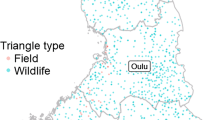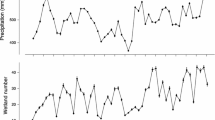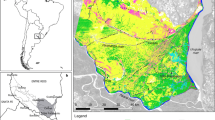Abstract
Populations exhibit spatial synchrony when their numbers rise and fall in concert at several sites over their distribution. I examined the relationship between synchrony, abundance of wetlands (ponds), distance, and agricultural cover using count data of ten duck species counted in 23 aerial survey strata on the mid-continental prairies of North America. Expansion of agriculture may have resulted in increased synchrony of duck populations through increased foraging efficiency of nomadic predators and/or if the homogenization of nesting habitat has removed habitat features that allow differential local responses to large-scale population drivers such as precipitation. As a measure of synchrony, I calculated all pair-wise cross-correlation coefficients based on population growth rates (r t ) at each survey stratum, and then regressed these correlation coefficients against measures of cross-correlation of pond (wetland) counts, distance between strata, and mean percent area of strata seeded to row crops. Synchrony for most species was most strongly related to synchrony of wetland availability among sites, and decreased with distance between sites. Synchrony of ducks that nest over water showed little effect of agricultural cover, whereas the effect of agricultural cover on synchrony of upland nesting ducks differed by species. Mobile large-bodied species showed evidence of increased synchrony due to agricultural cover, whereas smaller-bodied, more philopatric species showed evidence of decreased synchrony due to agricultural cover.




Similar content being viewed by others
Reference
Anderson MG , Rhymer J, Rohwer FC (1992) Philopatry, dispersal and genetic structure of waterfowl populations In: Batt BDJ, Afton AD, Anderson MG, Ankney CD, Johnson DH, Kadlec JA, Krapu GL (eds) Ecology and management of breeding waterfowl. University of Minnesota Press, Minneapolis pp 365–395
Austin JE, Afton AD, Anderson MG, Clark RG, Custer CM, Lawrence JS, Pollard JB, Ringelman JK (2000) Declining scaup populations: issues, hypotheses, and research needs. Wildl Soc Bull 28:254–263
Bataille KJ, Baldassarre GA (1993) Distribution and abundance of aquatic macroinvertebrates following drought in three prairie pothole wetlands. Wetlands 13:260–269
Bellamy PE, Rothery P, Hinsley SA (2003) Synchrony of woodland bird populations: the effect of landscape structure. Ecography 26:338–348
Bellrose FC (1976) Ducks, geese and swans of North America. Stackhouse Books, Harrisburg
Benton TG, Vickery JA, Wilson JD (2003) Farmland biodiversity: is habitat heterogeneity the key? Trends Ecol Evol 18:182–188
Bethke RW, Nudds TD (1993) Variation in the diversity of ducks along a gradient of environmental variability. Oecologia 83:242–250
Bethke RW, Nudds TD (1995) Effects of climate change and land use on duck abundance in Canadian prairie-parklands. Ecol Appl 5:588–600
Bjørnstad ON, Ims RA, Lambin X (1999) Spatial population dynamics: analyzing patterns and processes of population synchrony. Trends Ecol Evol 14:427–432
Buonaccorsi J, Elkinton J, Evans S, Liebhold A (2001) Spatial synchrony: issues in measurement and analysis. Ecology 82:1668–1679
Chevan A, Sutherland M (1991) Hierarchical partitioning. Am Stat 45:90–96
Cowardin LM, Gilmer DS, Shaiffer CW (1985) Mallard recruitment in the agricultural environment of North Dakota. Wildl Monogr 92:1–37
Crissey WF (1969) Prairie potholes from a continental viewpoint. In: Saskatoon wetlands seminar. Canadian Wildlife Service Report Series 6 pp 161–171
Devries JH, Citta JJ, Lindberg MS, Howerter DW, Anderson MG (2003) Breeding-season survival of Mallard females in the prairie pothole region of Canada. J Wildl Manage 67:551–563
Dufour KW, Clark RG (2002) Differential survival of yearling and adult female Mallards and its relation to breeding habitat conditions. Condor 104:297–308
Engen S, Lande R, Sæther B-E. 2002. Migration and spatiotemporal variation in population dynamics in a heterogeneous environment. Ecology 83:570–579
Evans KL (2004) The potential for interactions between predation and habitat change to cause population declines of farmland birds. Ibis 146:1–13
Grafen A, Hails R (2002) Modern statistics for the life sciences. Oxford University Press, Oxford
Greenwood RJ, Sargeant AB, Johnson DH, Cowardin LM, Shaffer TL (1995) Factors associated with duck nest success in the Prairie Pothole Region of Canada. Wildl Monogr 128:1–57
Hanski I, Woiwod IP (1993) Spatial synchrony in the dynamics of moth and aphid populations. J Anim Ecol 62:656–668
Haydon DT, Steen H (1997) The effects of large- and small-scale random events on the synchrony of metapopulation dynamics: a theoretical analysis. Proc R Soc Lond B Biol Sci 264:1375–1381
Ims RA, Andreassen HP (2000) Spatial synchronization of vole population dynamics by predatory birds. Nature 408:194–196
Johnson DH, Grier JW (1988) Determinants of breeding distributions of ducks. Wildl Monogr 100:1–37
Johnson DH, Sargeant AB, Greenwood RJ (1989) Importance of individual species on nesting success of ducks in the Canadian Prairie Pothole Region. Can J Zool 67:291–297
Kendall BE, Bjørnstad ON, Bascompte J, Keitt TH, Fagan WF (2000) Dispersal, environmental correlation, and spatial synchrony in population dynamics. Am Nat 155:628–636
Koenig WD (1999) Spatial autocorrelation of ecological phenomena. Trends Ecol Evol 14:22–26
Krapu GL, Klett AT, Jorde DG (1983) The effect of variable spring water conditions of Mallard reproduction. Auk 100:689–698
Krapu GL, Pietz PJ, Brandt DA, Cox Jr RR (2000) Factors limiting mallard brood survival in prairie pothole landscapes. J Wildl Manage 64:553–561
Larson DL (1995) Effects of climate on numbers of northern Prairie wetlands. Clim Change 30:169–180
Liebhold A, Koenig WD, Bjørnstad ON (2004) Spatial synchrony in population dynamics. Ann Rev Ecol Evol Syst 35:467–490
Lillegård M, Engen S, Sæther BE (2005) Bootstrap methods for estimating spatial synchrony of fluctuating populations. Oikos 109:342–350
Mac Nally R (2002) Multiple regression and inference in ecology and conservation biology: further comments on identifying important predictor variables. Biodivers Conserv 11:1397–1401
Manly BFJ (1991) Randomization and Monte Carlo methods in biology. Chapman and Hall, New York
Miller MW (2000) Modeling annual mallard production in the prairie-parkland region. J Wildl Manage 64:561–575
Moran PAP (1953) The statistical analysis of the Canadian lynx cycle II: synchronization and meteorology. Aust J Zool 1:291–298
Nudds TD (1992) Patterns of breeding waterfowl communities. In: Batt BDJ, Afton AD, Anderson MG, Ankney CD, Johnson DH, Kadlec JA, Krapu GL (eds) Ecology and management of breeding waterfowl. University of Minnesota Press, Minneapolis pp 540–567
Nudds TD, Elmberg J, Sjöberg K, Pöysä H, Nummi P (2000) Ecomorphology in breeding Holarctic dabbling ducks: the importance of lamellar density and body length varies with habitat type. Oikos 91:583–588
Paradis E, Baillie SR, Sutherland WJ, Gregory RD (2000) Spatial synchrony in populations of birds: effects of habitat, population trend, and spatial scale. Ecology 81:2112–2125
Phillips ML, Clark WR, Sovada MA, Horn DJ, Koford RR, Greenwood RJ (2003) Predator selection of prairie landscape success and its relation to duck nest success. J Wildl Manage 67:104–114
Pimm SL (1994) The importance of watching birds from airplanes. Trends Ecol Evol 9:41–43
Podruzny KM, Devries JH, Armstrong LM, Rotella JJ (2002) Long-term response of northern pintails to changes in wetlands and agriculture in the Canadian prairie pothole region. J Wildl Manage 66:993–1010
Ranta E, Kaitala V, Lindström J (1995) Synchrony in population dynamics. Proc R Soc Lond B Biol Sci 262:113–118
Ranta E, Kaitala V, Lindström J (1999) Spatially autocorrelated disturbances and patterns in population synchrony. Proc R Soc Lond B Biol Sci 266:1851–1856
Samson F, Knopf F (1994) Prairie conservation in North America. Bioscience 44:418–421
Sargeant AB, Greenwood RJ, Sovada MA, Shaffer TL (1993) Distribution and abundance of predators that affect duck production–Prairie Pothole Region. US Fish and Wildlife Service, Resource Publication 194
Shaw SP, Fredine CG (1956) Wetlands of the United States, their extent, and their value for waterfowl and other wildlife. US Fish and Wildlife Service Circular 39
Smith GW (1995) A critical review of the aerial and ground surveys of breeding waterfowl in North America. Biological Science Report 5. US Department of the Interior, National Biological Service, Washington, DC
Sovada MA, Zicus MC, Greenwood RJ, Rave DP, Newton WE, Woodward RO, Beiser JA (2000) Relationships of habitat patch size to predator community and survival of duck nests. J Wildl Manage 64:820–831
Sutcliffe OL, Thomas CD, Yates TJ, Greatorex-Davis JN (1997) Correlated extinctions, colonizations and population fluctuations in a highly connected ringlet butterfly metapopulation. Oecologia 109:235–241
Turner BC, Hochbaum GS, Caswell FD, Nieman DJ (1987) Agricultural impacts on wetland habitats on the Canadian Prairies. Trans North Am Wildl Nat Resour Conf 52:206–215
Vickery WL, Nudds TD (1984) Detection of density-dependent effects in annual duck censuses. Ecology 65:96–104
Viljugrein H, Stenseth NC, Smith GW, Steinbakk GH (2005) Density dependence in North American ducks. Ecology 86:245–254
Ydenberg RC (1987) Nomadic predators and geographical synchrony in microtine population cycles. Oikos 50:270–272
Acknowledgements
Mark Koneff of the US Fish and Wildlife Service provided pond data when they were otherwise unavailable, and Mark Miller provided data on agricultural land use. Bob Clark, Ben Dalziel, Ronnie Drever, Dan Haydon, Kevin McCann, Tom Nudds, Scott Robinson, Neil Rooney, Bernt-Erik Sæther, John Simpson, and two anonymous reviewers improved an earlier version of this manuscript. Funding was provided by the National Science and Engineering Research Council, University of Guelph, and the Delta Waterfowl Foundation.
Author information
Authors and Affiliations
Corresponding author
Additional information
Communicated by Scott Robinson
Rights and permissions
About this article
Cite this article
Drever, M.C. Spatial synchrony of prairie ducks: roles of wetland abundance, distance, and agricultural cover. Oecologia 147, 725–733 (2006). https://doi.org/10.1007/s00442-005-0308-9
Received:
Accepted:
Published:
Issue Date:
DOI: https://doi.org/10.1007/s00442-005-0308-9




